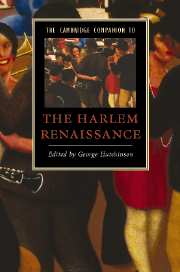3 - International contexts of the Negro Renaissance
from Part I: - Foundations of The Harlem Renaissance
Published online by Cambridge University Press: 28 July 2007
Summary
The exceptional character of the Harlem Renaissance as a watershed of selfdirected “Negro” arts and letters and the popular view of its centralization in Harlem have led to an unfortunate occlusion of its international dimensions. The “New Negro Movement” bloomed within a global network of epiphenomenal cultural nationalisms and folk revivals. In the first two decades of the twentieth century, pulses of decolonization rippled throughout Asia, the Caribbean, and Ireland, catalyzed by China's 1901 Boxer Rebellion, the Russian Revolution of 1917, and postwar efforts to accommodate European ethnic minorities in their struggles for self-determination. Much of the scholarship surrounding the Harlem Renaissance, however, has approached it at the expense of the global as a phenomenon of primarily national significance despite the persistent emphasis on internationalism in the works and life experiences of the movement's leading figures. Even when this emphasis is noted, as with the much-studied Negro vogues of Paris and Berlin, the international scope of the movement's influence and impact has been conceptualized according to an American context rooted in slavery, reconstruction, migration, and segregation. Nevertheless, a few scholars, such as Robert Stepto, Michel Fabre, and Melvin Dixon, have outlined the global contours of the Harlem Renaissance currently being reexamined and theorized anew by Brent Hayes Edwards, George Hutchinson, and others, so that the transnational shape of the movement and the disparate worldviews of its writers may come more fully into view.
- Type
- Chapter
- Information
- The Cambridge Companion to the Harlem Renaissance , pp. 41 - 54Publisher: Cambridge University PressPrint publication year: 2007
- 1
- Cited by



